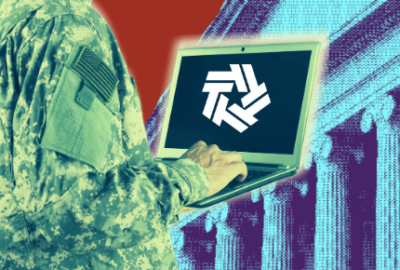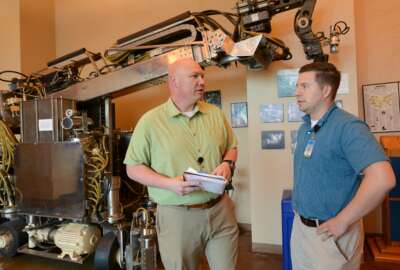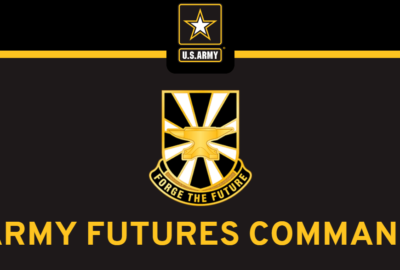A look inside the Army’s strategy to modernize its medical operations
Army brass have been pursuing a modernization strategy for some time now via the Army Futures Command. It's focused on doctrine and lethality and the systems to...
Best listening experience is on Chrome, Firefox or Safari. Subscribe to Federal Drive’s daily audio interviews on Apple Podcasts or PodcastOne.
Army brass have been pursuing a modernization strategy for some time now via the Army Futures Command. It’s focused on doctrine and lethality and the systems to keep the Army out front. But Futures Command is also looking at modernizing another component where the Army has historically innovated, namely, its medical operations. For an update, the Federal Drive with Tom Temin turned to the chief of medical readiness and integration and futures command, Col. Mike Mansell.
Interview transcript:
Mike Mansell: As the Army moves forward and we get into multi-domain operations, the medical force also has to modernize in step with that. And what that means is, as the line site moves faster, the medical force also has to move faster. So we need to be able to see, understand and act at the speed of relevance in order to support the operations that the lineside are doing. What that means is on a data-driven battlefield, we need to be able to acquire data process that understand it and be predictive and where our medical forces are going and our resources so that we can optimize the ability to support that force and maintain momentum on the battlefield.
Tom Temin: It sounds like then, as the Army becomes, I think, in its words or at least in concept, much more mobile, much more agile with smaller units, then the medical corps has to be close to where the action is basically?
Mike Mansell: Yes, what’s going to happen is as we start to move in to conflict with near peer adversaries, we’re not necessarily going to have that air dominance and movement dominance that we saw in the Middle East over the last few conflicts we’ve had. So we’ve got to be able to A) provide prolonged care at the point of injury, and then optimize golden windows where we can move our patients to wherever they need to go. Now one of the concepts that we’re looking at is called medical convergence, where there’ll be more of an AI-enabled machine learning concept, where data will come up through the system to our medical common operating picture. AI will basically run through what our theater assets are, what’s in that location, and direct medivac to either might be a Navy ship might be an airfield might be an army facility, but whatever’s closest that can provide the proper care. And that’s what our end state would obviously be for this strategy.
Tom Temin: And one implication of that is that the other armed services in joint operations would have the same ability to take in Army people just as army people might take on their people, whoever is most available?
Mike Mansell: Yes. We’re no longer going to fight as individual forces. I think that’s a pretty commonly agreed upon concept between the services. So medical is medical, we treat a sailor the same as a Marine as a airman, cadet, whatever you want to call them nowadays. They’re all people and we’re a people-first organization, it doesn’t matter where they’re coming from. And in reality, we’re not going to be able to walk through echelon the way we did in Europe and former battles. We’re going to have to help each other out if we’re going to be successful in the future battlefield.
Tom Temin: And the other implication of what you said is that medical corps people, the actual operators in the medical domain, it seems like they’d be more distributed in smaller numbers, but more scattered along with where the operating units are, whatever arm branch, as opposed to the model people have maybe from old TV shows, or whatever movies of the medic operation somewhere way behind the lines, but a large centralized facility.
Mike Mansell: Yeah, we’re used to seeing those big field hospitals, but we’re going to be fighting a very dispersed formation type operation, especially in the Pacific, where our adversaries are going to have the same ability to pinpoint us the way we pinpoint them. So large field hospitals are probably not going to be what you see in the future, we’re going to have to be dispersed, lighter, more mobile, and more capable at the point of injury. One of the concepts in the strategy is, our medics will be trained to a level higher than what they are now almost an EMS and then paramedic-type of situation. And then the individual soldier is also going to have to step up and be trained to aid that medic, because we’re not going to have enough medics to handle what we’re considering is our combat losses or our injuries at that point of injury. So it’s really broadening the scope of medicine, it’s broadening the capability of the individual soldier. And then we get into things like telehealth and things like that, that can also help the medic at point of injury. But, we’re fighting bandwidth issues and jamming and things like that. So it’s really putting a lot of emphasis back on the individual soldier to help out and it’s also going to change how we really triage our soldiers because what might be an injury that takes you out of the battle in Iraq or Afghanistan may turn you into a care provider on this battlefield.
Tom Temin: Interesting. We’re speaking with Col. Mike Mansell, he’s chief of Medical Readiness and Integration at the Army Futures Command. And what about medicine itself, the actual tools, techniques, procedures, doctrines if you will, of medicine, because there have been a lot of advances in bleeding control and stabilizing people, monitoring people’s health right at the field level? Does modernizing of the medical practice itself become part of this?
Mike Mansell: Yes, actually Army Medicine, we’re at the forefront of current modalities and treatments and materials. We’re always very good with that. What we have to do now is really started looking at our supply and how we get those materials and those resources to the people who can utilize, and that’s going to be a huge issue. But also, as we innovate, as industry innovates, we also have to be agile enough to integrate those technologies into what we’re doing, and field harden them or make them military mobile versus civilian mobile-type of thing where they can survive in extreme austere environments. We’re going to be going from 100 and something degrees in Iraq to who knows, we may be in the Arctic, someday, where we’re looking at negative temperatures. So all of our materials, all of our equipment need to be able to handle all of those extremes. Now, we’re also looking at novel viruses like COVID, look what that did to the country. And to say that that won’t be seen on the future battlefield is naive. So we got to be able to be flexible enough within our research facilities, MRDC also working with academia and industry, to be able to quickly develop and safely push out these vaccines or other medicines to our fighting force so that a virus such as a COVID comes along and doesn’t knock us out.
Tom Temin: Yeah, sounds like some of the battle situations are worse than certain neighborhoods in Seattle, I guess?
Mike Mansell: It’s true, that is true.
Tom Temin: And as this gets promulgated, what are the first steps toward operationalizing this strategy? How do you get from here to there?
Mike Mansell: The first thing is identifying our gaps. And what we’re missing in our force now to our future force and our Medical CDID [Capability Development Integration Directorate] that has done a fantastic job with that. And we are moving forward with requirements to close those gaps. Obviously, as you get a disruptive technology that pops up, we need to be agile enough to acquire that and integrate it into our course. But really that requirements process and identifying where our gaps are, that’s the first step. And once we get back going, we reduce our gaps, then we can expand into how are we going to look in 2040 and beyond? What do we want the medical battlefield to look like? And that’s going to really be a joint concept that will eventually come along.
Tom Temin: Is there any civilian area domain or say state or local type of model that can have any learning for the Army in this?
Mike Mansell: We do put a lot into our looking at how our EMS systems work. Also the military was involved in the COVID response. So we had things like the NETCCN [National Emergency Tele-Critical Care Network] the network that helped with the COVID response. So there is a very good interaction between our civilian counterparts and the military. And a lot of our military providers are also working in trauma facilities just to keep their skills up. So we do have a very tight relationship with our civilian counterparts. Yeah, we’re always looking at what they’re doing because like I said, people are people. And our soldiers are the same as anyone else who shows up into an emergency room. And I hate to say we don’t see it in the civilian side but we are, but we probably see a lot more trauma in the military on the battlefield that we’ve got to be able to take care of. So we’re always looking at that and what other technological advances and advances in the biosynthetic world, blood products, grafting materials, all that stuff. Like I said, we were doing a lot of research on it. We’re at the forefront of most of these materials right now.
Tom Temin: And one final question on a detail here, you mentioned the golden window, which is the time immediately after an injury when you can have the most effect with someone for the most positive outcome, that kind of magic hour after a heart attack type of parallel. And the strategy mentions robotics and drones to help mitigate the first mile problem. Tell us more about that.
Mike Mansell: So the golden window, it kind of combines a whole bunch of “golden concepts.” It was the golden hour, that first hour after the injury that if you can treat the patient within that time or get them to where they need to be their life expectancy increases. We’ve got to be able to extend that time, especially in the theater such as the Pacific to least 24 hours to where we can wait for that “golden window” to open up so that we can move the patient. Now that “golden mile” is another concept that we can use autonomous vehicles, semi-autonomous vehicles to take a stabilized patient at the point of injury, use an autonomous vehicle to move them maybe a terrain feature back to a medical holding area that can then process them, treat them or move them in a safer manner that doesn’t put medics or personnel at danger moving through an area that’s in direct conflict with the enemy or even a sea burning area where sending personnel in obviously as a risk due to the sea burning environment. You send it in an autonomous vehicle, you don’t have to worry about that.
Tom Temin: And looking at the technologies we’ve spoken about, it seems like these are mostly commercially available. I mean, futures command is looking for innovative technologies across the spectrum of Army requirements. Are most of what you need to implement this in terms of technology and products already out there.
Mike Mansell: We are working very closely with industry partners and academia to incorporate what they have into what we need. Is it right there today? It probably is. Is it what we needed to do on the battlefield? Probably not there yet. There’s also some ethical things we’ve got to look at in terms of autonomous movement of patients. It’s a lot more than just sticking a patient in an autonomous vehicle. It sounds easy in concept, but there’s a lot of other things that we got to take into account. But the technology is almost there. Obviously, the battle side of autonomy is getting a lot of push by [Army Futures Command]. We’re making extremely quick progress in that area. But we still got some work because what works in the civilian world may not necessarily work on the battlefield the way we want it to.
Copyright © 2025 Federal News Network. All rights reserved. This website is not intended for users located within the European Economic Area.
Tom Temin is host of the Federal Drive and has been providing insight on federal technology and management issues for more than 30 years.
Follow @tteminWFED






